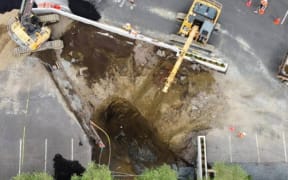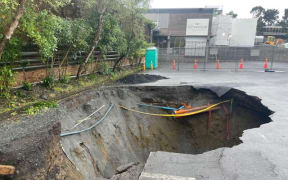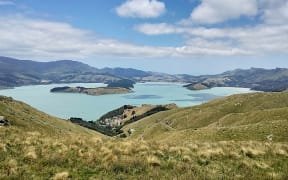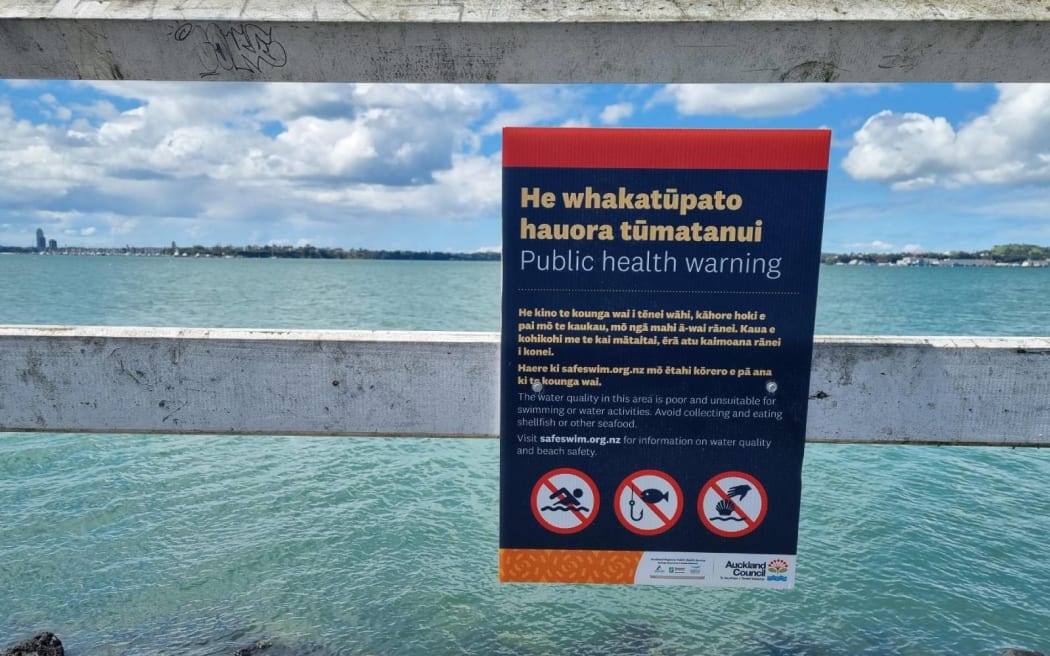
A sign warns locals against swimming and fishing at Okahu Bay. Photo: Amy Williams / RNZ
Signs warning Aucklanders to stay out of the water and not fish are likely to be permanent on a number of inner city wharfs and beaches this summer.
Millions of litres of sewage per second spilled into the Waitematā Harbour when the Ōrākei sewer collapsed six weeks ago.
But the contaminated water has not stopped some people heading to the beach. Tim Randall was among a dozen keen fishers casting out lines at Okahu Bay wharf this week.
"If you could see today the amount of people that are fishing, you would know that everybody's not worried, which is a bit stupid in some ways but I think people think they've got to eat."
He said it was a popular place to hook dinner.
"Snapper, gurnard, piper, yellow tail, kingfish sometimes."
Another fisher was there to give family from overseas a new experience, and said they might eat their catch despite the public health warning.
"It depends I guess what size and what type of fish - we don't know much so we'll have to google it and see. But [we've come] to have fun and enjoy it."
Auckland Regional Public Health Service (ARPHS) said pathogens from sewage accumulate in seafood.
A bypass pipe was installed to stop the spill, but ARPHS warned against fishing for at least 28 days after an area is polluted.
University of Auckland marine scientist Dr Andrew Jeffs said there was probably a pile of poo on the seafloor near the discharge points at Mechanics Bay and Wynyard Basin.
"It usually takes about a month for it to dissipate but for a large event like this it may take quite a lot longer, especially if there's faecal material that's being released again and again from a pile that's accumulated at the outfall."
Watercare is using underwater cameras to inspect the seabed. The results are not available yet.
Testing to continue until Christmas
Environmental care manager Nathaniel Wilson said recent testing showed the worst of the pollution was contained at the discharge points - and most of the 'solids' were stuck to the pipes.
He said they would continue extensive water testing in the harbour until at least Christmas.
"While it is too early to reach conclusions, what we are seeing so far indicates the impact of the high-volume overflows is concentrated on the area in the immediate vicinity of the overflow locations at Mechanics Bay across to Wynyard Quarter," Wilson said.
"The nature of the harbour means there was sufficient dispersion and dilution to significantly reduce the impact to water quality at locations further from the discharge point."
He said that is why most of Auckland's swimming beaches had Safeswim green water quality pins on Safeswim soon after the overflows ended.
Auckland Council's Healthy Waters team manages the Safeswim alerts. Its website showed black pins over eight inner city beaches.
The team is testing the water three times a week.
Testing the water 'a learning curve for us all'
Wading in at Herne Bay Beach, water sampler Jess Brooks wore sea boots and held a pole with a container attached, to collect 400 millilitres.
"We'll wade out to knee depth, collect that sample, document it, we trace it through our system with barcodes… and then we'll pop it in the car in the chilly bin and then once we're done the day sampling we'll take them over to Watercare labs."
Brooks said they test for faecal matter bugs and could not tell by just looking at the water if it was contaminated.
"Every day is different, so sometimes the data's not quite what you'd expect and we've never had an incident like this before, so it's a learning curve for us all."
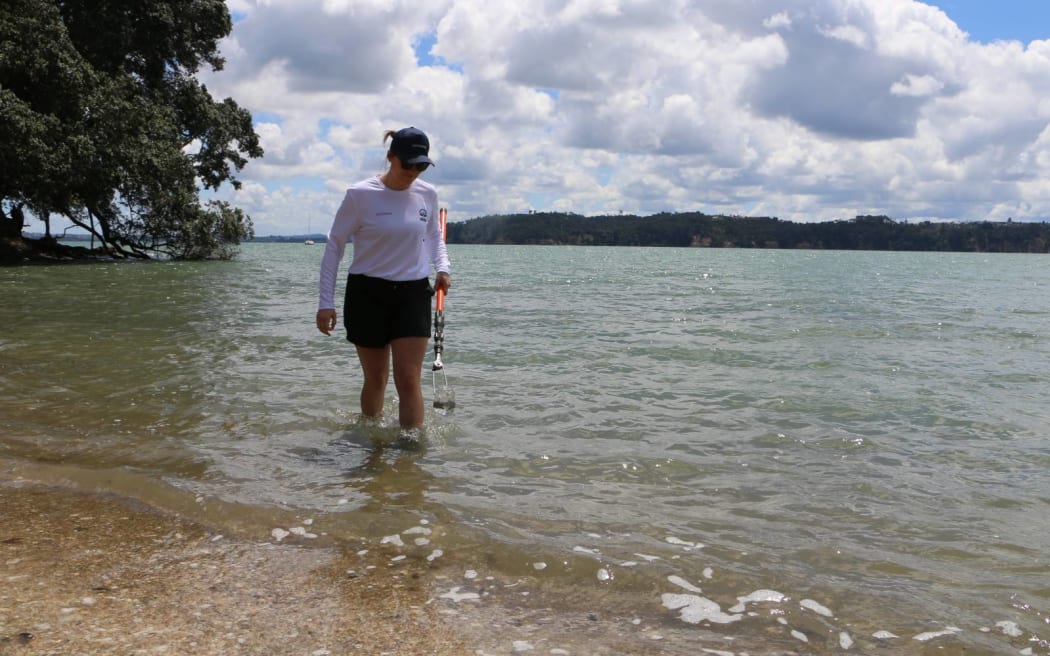
Water sampler Jess Brooks. Photo: Amy Williams / RNZ
Healthy Waters head of planning Nick Vigar said test results showed pollution on beaches was marginal, considering the magnitude of spilled sewage, because the spill went further out into the harbour.
But he warned a cautious approach was needed because a drop of rain can result in an overflow from the bypass pipe.
"When we had the Orakei main discharging into the harbour I think people would be surprised at how little impact there was on some of the beaches. Even so, we've taken a fairly cautious approach so that we haven't taken those black pins off. With those discharges out into the harbour [there's been] surprisingly little impact on some of the swimming beaches."
Vigar expected pins to remain on some of them over summer, until a permanent fix was in place for the Ōrākei sewer.
"We're very aware that while all the evidence is that there are no dry weather spills it's much more borderline than normal and that's why we're taking a little more caution than normal, because it won't take much in terms of increased flows to start spilling."
The black pins were on Herne Bay, Home Bay, Sentinel Road Beach, Masefield Beach, St Mary's Bay, Judges Bay, Te Tinana and Okahu Bay.
A rāhui remains over the inner harbour.
Wilson said Watercare would contribute to its restoration.
"As we don't yet have a comprehensive understanding of the environmental impact on the Waitematā Harbour, we don't have a confirmed restoration plan.
"However, we recognise that the wastewater overflow event did impact the harbour, and we are looking for opportunities to contribute to initiatives that will protect and restore it."

